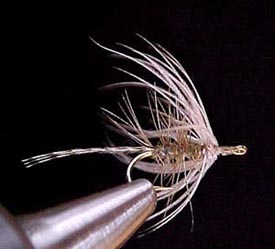 |
||
|
|
||
|
Charles Cotton’s Unbarbed Fly Materials: 1.
Tie on near the rear of the hook shank. We are tying a mayfly so we tie
in tails, in this case wood duck fiber tails. On a pattern without tails, attach
the thread one eye length behind the eye of the hook. 2.
Wind the thread forward to a point one eye length behind the eye. Tie in
the wing hackle on top of the hook shank. The hackle feather has slightly more
fibers stripped off of what will be the bottom edge of the feather and is tied
in with a short section of bare stem between the feather fibers and the thread
wraps. Preparing the feather in this way makes for a neat first turn. Try to
match the color of the natural insect’s wings. The barbs should be
considerably longer than those of a dry-fly hackle you’d normally use. 3.
Wind three to five close turns of hackle toward the bend of the hook.
Catch the tip of the feather with a couple of wraps of thread. 4.
Attach the body hackle immediately behind the wing. The glossy side (top
side) of the feather faces you. Leave a little bare stem between the thread
wraps and the first barbs. 5.
Apply dubbing very sparsely to the thread, if you are using dubbing. Wrap
the dubbed thread rearward, stopping just before the last wrap of the tail
windings. Strip any excess dubbing from the thread. 6.
Wind the body hackle to the rear in a spiral. Catch the tip of the
feather with the thread. 7.
Spiral the thread forward through the body and wing hackles, making a rib
while reinforcing the hackle stems. Wind a small head and tie off the thread. 8.
Trim the fibers on the bottom of the fly. 9.
You can also trim the fibers on top of the body, and a few along the
sides. If the fibers of the wing hackle are too long, you can trim them, too. 10.
On a small fly, one feather can serve as wing and hackle. Make three or
four close turns at the front, then spiral the hackle back over the body.
Click the BACK button on your browser to return to the fly pattern index page. |
||
